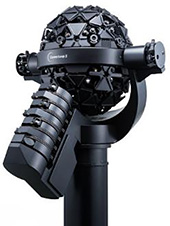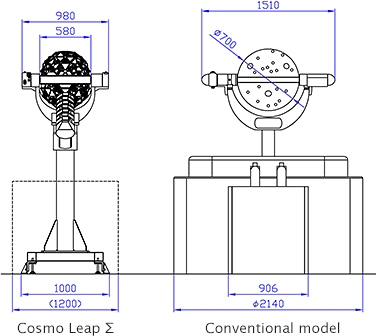News Releases
Konica Minolta Releases the Cosmo Leap Σ,
a Versatile Optical Planetarium That Projects Beautiful Stars
Reproducing Beautiful Stars in the Dark Sky in Small- to Medium-sized Domes
Tokyo (May 22, 2017) - Konica Minolta Planetarium Co., Ltd. (Konica Minolta) has developed and released the Cosmo Leap Σ, an optical planetarium for small- and medium-sized domes that is particularly designed to reproduce the twinkling stars.
The Cosmo Leap Σ can project the starry skies equivalent to those of the Infinium Σ (Konica Minolta’s flagship optical planetarium that was developed to reproduce beautiful fixed stars shining in the dark night sky) in small and medium-sized domes with an energy-efficient compact design.

Homes and schools cannot readily provide children with stargazing opportunities because they have to take children out at night and need telescopes. In municipalities across Japan, planetariums are used as facilities where both children and adults can enjoy learning about the universe. The Cosmo Leap Σ achieves sharp stellar images with various constellation images and realistic reproduction of variable stars (i.e., features suitable for giving a detailed narrative of the starry skies) and impresses the audience by projecting beautiful night skies embellished with glittering stars.
Values offered by the Cosmo Leap Σ
1. A compact projector suitable for detailed narratives of the starry skies
The Cosmo Leap Σ is one of the most compact planetariums incorporating a planet projector in the world (height: 2.5 m, installation area: 1 m2) which offers various functions suitable for giving detailed narratives of the starry skies. The product has been achieved by utilizing Konica Minolta’s cutting-edge optical, micromachining, and machine control technologies.
Konica Minolta has become the first company in the world to succeed in building 80 additional projections including 62 constellation images, 5 constellation lines (e.g., Cassiopeia), and 13 sky markers (e.g., the Summer Triangle) into a star ball, which can also project 48 deep sky objects including nebulas/star clusters and external galaxies.
The function for the variable stars has been achieved based on the latest research results. Konica Minolta asked Dr. Hiroyuki Maehara of the National Astronomical Observatory of Japan (one of the leaders in research on variable stars) for supervision.

2. Bright twinkling stars achieved by ultra bright LEDs with low power consumption
The combination of ultra bright LEDs with optical technology has increased the brightness of stellar images projected on the screen approximately 2.5-fold compared to the conventional model, while the power consumption has been almost halved (about 1.4 kW).*
While the conventional model uses 12 separate star plates to project the whole sky (360°), the Cosmo Leap Σ uses 32 separate star plates, which are equivalent to those of the flagship model (the Infinium Σ). The brightness level can be fine-tuned for each projected star, achieving gradation close to that of the actual starry skies.
“Bright stars” (i.e. first magnitude stars or brighter ones) are projected using an independent unit to reproduce their outstanding glow in the whole sky. The five planets (e.g., Mars, Venus) are brighter than the bright stars. A detailed narrative of Venus can be given in a life-like setting as the first celestial body that can be spotted in the evening.
3. Increased work efficiency achieved by improved maintainability
The Cosmo Leap Σ uses only high brightness LEDs as light sources, eliminating the need to replace lamps and protection fuses. Daily maintenance requires only cleaning of the air intake filters and exterior surfaces, contributing to improved work efficiency.
The reduced maintenance time helps planetarium staff concentrate on narrating and running programs, resulting in an improved experience for the audience.
Regarding equipment installation, the key preliminary adjustments will be made at the production site to reduce the on-site installation and adjustment period to about one week (about one third of the conventional method).
Main specifications of the Cosmo Leap Σ
| Suitable dome diameter | 8–18 m (horizontal) |
|---|---|
| Projection method | Lens projection using ultra bright LEDs (lifetime: 30,000 hours) and 32 separate star plates |
| Maximum power consumption | 1.4 kW (standard specifications) |
| Outside dimensions of the main unit | 980 mm (W) × 960 mm (D) × 2,530 mm (H) (when the horizontal height is 2.2 m) |
| Installation area of the main unit | 1 m (W) × 1 m (D) * Excluding fence |
| Fixed stars | Approx. 9,000 (down to 6.5 magnitude stars: depending on the dome diameter) |
| Milky Way | 250,000 stars processed on star plates (standard specifications) |
| Color reproduction | Particular colors of 97 stars (down to 2.5 magnitude stars) |
| Bright stars | 27 * Including 4 variable stars (Mira, Algol, Betelgeuse, and Dschubba) |
| Functions of bright stars |
|
Under the brand proposition “Giving Shape to Ideas,” Konica Minolta will offer systems and services to create new value in the field of science education.
*Comparison with COSMOLEAP – 10 manufactured by Konica Minolta
